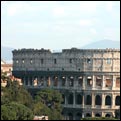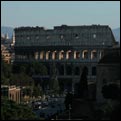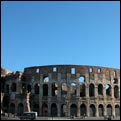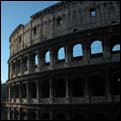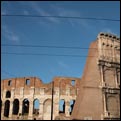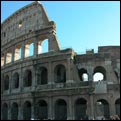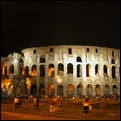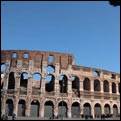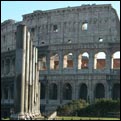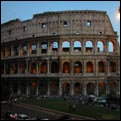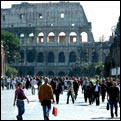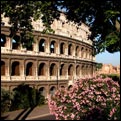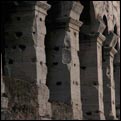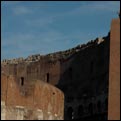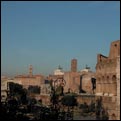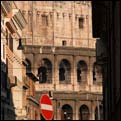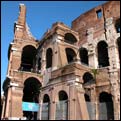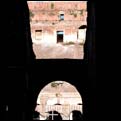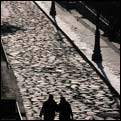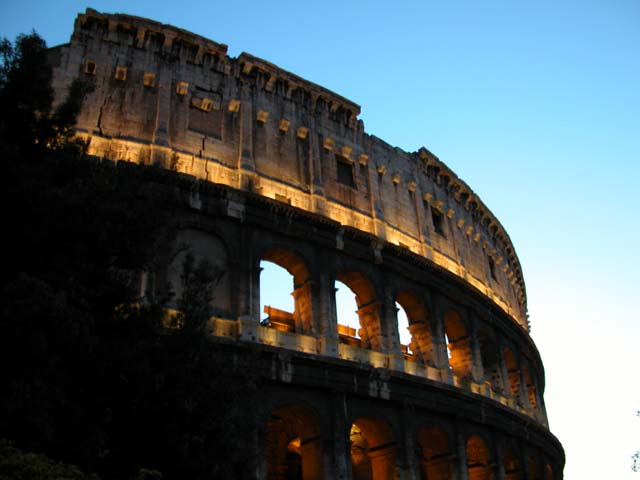
second part
One object at the terminus of the Sacred Way completely filled my vision. It was the Colosseum. I wonder if to any traveler in the world this building has proved disappointing. I cannot think it possible. All things considered, nothing in Rome can equal it in grandeur. It is the King of Ruins, desolate but defiant, dethroned and yet sublime. Simple, majestic, solitary, and unique ; tinted by the suns of nearly twenty centuries, it rises at the union of the Sacred and Triumphal Ways, like the colossal skeleton of Roman power. Before it stands the almost shapeless mass of the Meta Sudans, the fountain where it is supposed the gladiators used to bathe after the combat, surrounded, no doubt, by a gaping crowd, and petted and admired by effeminate patricians, who, with their soft white hands, patted the brawny muscles of the athletes and offered wagers on their next encounters. Human nature has not greatly changed in this respect in eighteen hundred years.
Slowly I made the circuit of the Colosseum, counting the eighty arches leading to the interior. The eighty-seven thousand people who were often gathered here could find abundant and substantial avenues of entrance and of exit. The outer corridors are made of massive blocks of stone, piled one upon another and then bound together by iron clamps, as if to last while Time endured. Thousands of ragged holes in these huge stones show how the highly valued metal was extracted from them in the Middle Ages. There was no danger here of panic or collapse. Woe to the man who trifled with the public in those days ! An architect named Atilius tried it once, and built in a provincial town a flimsy amphitheatre which fell, occasioning great loss of life. Tacitus says that fifty thousand people were crushed to death or maimed by this disaster, and then relates the builder's punishment in three short words, which ought to be inscribed above the door of every wretchedly built theatre in the world, " Atilius was banished."
I had supposed that all the pictures I had seen of the interior of this mighty edifice would make astonishment impossible ; but nothing had prepared me for the grand reality. The rows of ruined arches, rising in a gigantic circle toward the sky, are overpowering in their immensity, and the huge doorways seem like caverns in a mountain side, from which wild beasts may even now emerge. To climb to the highest tier, as can be done easily by stairways, and to look thence down a hundred and fifty feet, as into the enormous crater of a dead volcano, gives one a sensation obtainable nowhere else in the whole world.
The walls have now been scraped and cleaned of all the vegetation which had for centuries accumulated on their broken surfaces ; but, formerly, wherever wind-blown seeds had found a foothold on these curving slopes, as on a natural hillside, vines twined their arms around the Colosseum's massive columns, as if to hide the memory of its crimes, grasses swayed lightly in the mighty arches, lichens crept timidly along the sides of the arena, and life so far succeeded in replacing death, that botanists were able to compose a large herbarium of plants and flowers growing on these walls. The arena, also, has been largely opened to the day, and one can trace there now, some twenty feet below the arena, the dens for the wild beasts, the openings through which they were fed, the corridors through which they rushed to the arena, and the apartments where the gladiators waited until called to conflict, probably to death.
To furnish entertainment here for the Roman people the entire world was ransacked to secure wild beasts, which it was a crime to kill. Some nations, conquered by the Romans, had to pay tribute to them not only in money, but in lions, panthers and tigers, which were slaughtered in almost incredible numbers. By order of Julius Caesar four hundred lions contended at one time, and Caligula caused five hundred bears to be killed in a single day. Think what a task it must have been to capture and convey to Rome, unwounded and alive, these thousands of ferocious beasts ! Before the sports in the arena these animals were usually kept in dens or cages, and people were allowed to inspect them. They thus enjoyed the double pleasure of seeing them fight, first in imagination, then in reality. Barnum should have been born eighteen hundred years ago. With such advantages he would have been the " noblest Romanof them all." In many conflicts, however, no animals appeared, and only gladiators fought with one another to the death. The well-known painting by Gerome portrays a scene of frequent occurrence in those days.,. Thousands of men and women, intent upon the combat, are represented glaring with bated breath into the whirl and dust of the arena. The victor pauses in compassion to read the verdict of the populace. The victim also lifts his arm in piteous appeal. Alas ! the thumbs of all are turned inexorably downward. It is the fatal signal. The gladiator must die. It seems almost incredible that men should have consented to be butchered thus, merely to make a Roman holiday. Many of them were slaves, or prisoners of war, whose lives were considered of so little value that, while accounts were kept of all the expensive elephants and tigers killed, no reckoning seems to have been made of the loss of men ! Yet, at least ten thousand athletes were always kept in readiness for the Colosseum, all of them trained to kill one another, and every one of them certain, sooner or later, to be slain. It has always seemed strange to me that they did not combine more frequently, as Sparticus and his associates did in the days of the Republic, and lose their lives at least, if die they must, in fighting for their liberty.
Since this building was, for nearly four hundred years, the scene not only of gladiatorial combats, but, frequently, of Christian martyrdom, the Church has long regarded it as consecrated ground. Accordingly thirty years ago there stood around the outer edge of the arena, which was carpeted with turf, a line of chapels dedicated to the memory of Christians who had here found death ; while in the centre rose like an inverted sword, no longer used for bloodshed the Cross of Christ, emblem of peace and love. I sometimes wish those objects had not been removed, for what could better emphasize the facts of history than the impressive symbol of Christianity, rising above the very place where had so often flowed the blood of its heroic martyrs ? Here, too, on every Friday afternoon a sermon would be preached, teaching how much the Christian faith once cost, yet how that faith had triumphed over imperial Rome. Does it seem possible that eighty thousand people could be found so bloodthirsty and cruel as to look calmly down upon their fellow-men burning in agony as torches, or torn in pieces by wild beasts ?
Can we believe, however, that among those multitudes not one felt pity for the fearless victim who, without weapons, knelt to offer up a prayer, the words of which were lost amid the roar of famished monsters ? Were not some responsive hearts impressed and even thrilled by the heroic faith of St. Ignatius who, as the wild beasts leaped into this arena to devour him, exclaimed in a loud voice, "I am as the grain of the field, and must be ground by the teeth of lions, that I may become bread fit for my Master's table"? It was through the influence of Christianity that the gladiatorial combats, finally, came to an end. Four hundred years had rolled away since Christ first taught the brotherhood of man ; when, one day, an Oriental monk, Telemachus by name, shocked at these scenes of cruelty and carnage, rushed into the arena, restrained the conqueror's uplifted arm, and begged not only him, but the spectators also, to renounce such deeds forever. Instead of listening, they stoned him to death. Yet he did not die in vain. Christianity had then become the State religion, and so deep and lasting was the influence caused by his protest, that presently the decree went forth that these huge walls should no more echo to the yells of triumph, or to the groans of dying men.
Gigantic as the Colosseum is, two-thirds of it has now disappeared. In the fourteenth century it was looked upon as a legitimate quarry from which to extract building materials. Four thousand workmen labored at one time in tearing down its walls. In the year 1452 two thousand five hundred cartloads of it were removed, and furnished material for some of the largest palaces of Rome. "There is no longer any doubt," says the great archaeologist, Lanciani, "that the Romans have done more harm to their own city than all invading hosts put together. The action of centuries of natural phenomena, such as hurricanes, earthquakes, fires, and inundations, could not have accomplished what men have willingly and deliberately done."
JOHN L. STODDARD'S LECTURES - ROME - 1898

